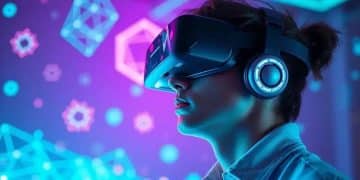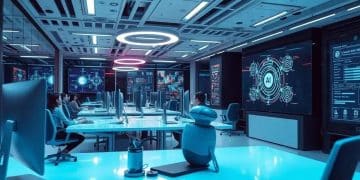What’s new in virtual lab simulations
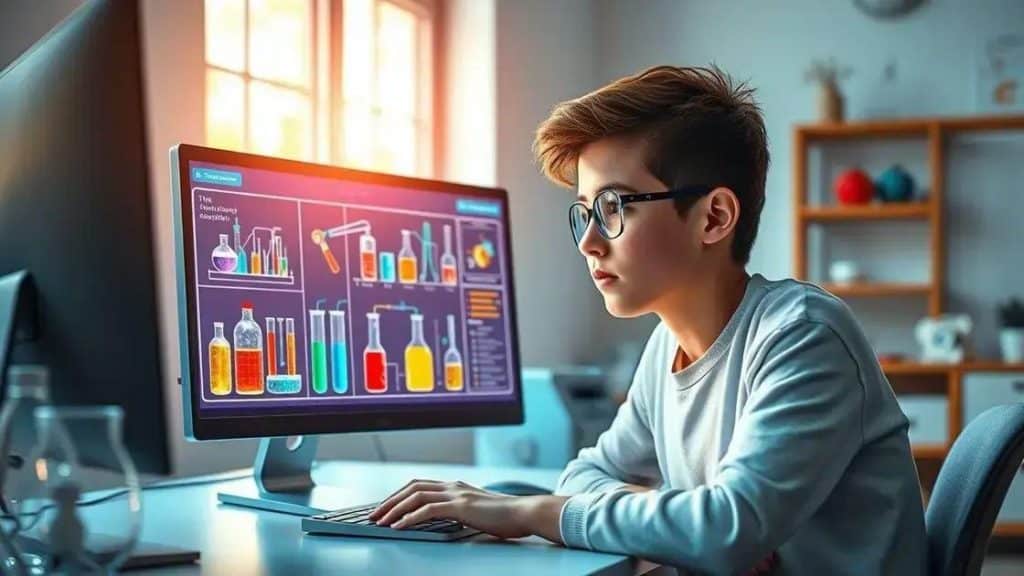
Virtual lab simulations enhance students’ learning by providing safe, interactive environments for conducting experiments, fostering collaboration, and integrating advanced technologies like AI and VR for personalized educational experiences.
What’s new in virtual lab simulations? These innovative tools are changing the way students engage with science, offering interactive environments that mimic real-world scenarios. Have you ever wondered how these advancements make learning more effective and engaging?
Advancements in technology for virtual labs
With the rise of new technologies, virtual lab simulations have transformed educational practices. These advancements are making learning more engaging and accessible for students worldwide.
One of the most significant advancements involves the use of augmented reality (AR) and virtual reality (VR) in labs. These technologies allow students to immerse themselves in interactive environments that replicate real-life scenarios. For instance, students can explore complex biological systems or conduct chemistry experiments without the risks associated with physical labs.
Key technological advancements in virtual labs
- Real-time simulations: Students can conduct experiments in real-time, observing immediate feedback and results.
- Collaboration tools: Many platforms now offer features that allow students to collaborate from different locations, enhancing teamwork skills.
- Data analytics: Programs can analyze students’ performance, helping educators identify areas where they may need additional support.
Another essential feature of modern virtual labs is cloud-based technology. This allows easy access to simulations from any device, making learning more flexible. Whether at home or in school, students can engage in their experiments anytime, aiding those who may struggle with traditional lab settings.
Furthermore, the incorporation of artificial intelligence in virtual labs is a game-changer. AI can adapt simulations to meet individual student needs, providing personalized learning experiences. This means that no two students have to learn at the same pace. What works for one student may not work for another; AI ensures everyone can succeed.
As technology continues to evolve, the possibilities for virtual labs seem endless. Innovations such as machine learning and blockchain may further enhance the security and effectiveness of lab simulations. Students and educators alike can look forward to a future where learning is more interactive, insightful, and tailored to individual needs.
Benefits of virtual lab simulations for students
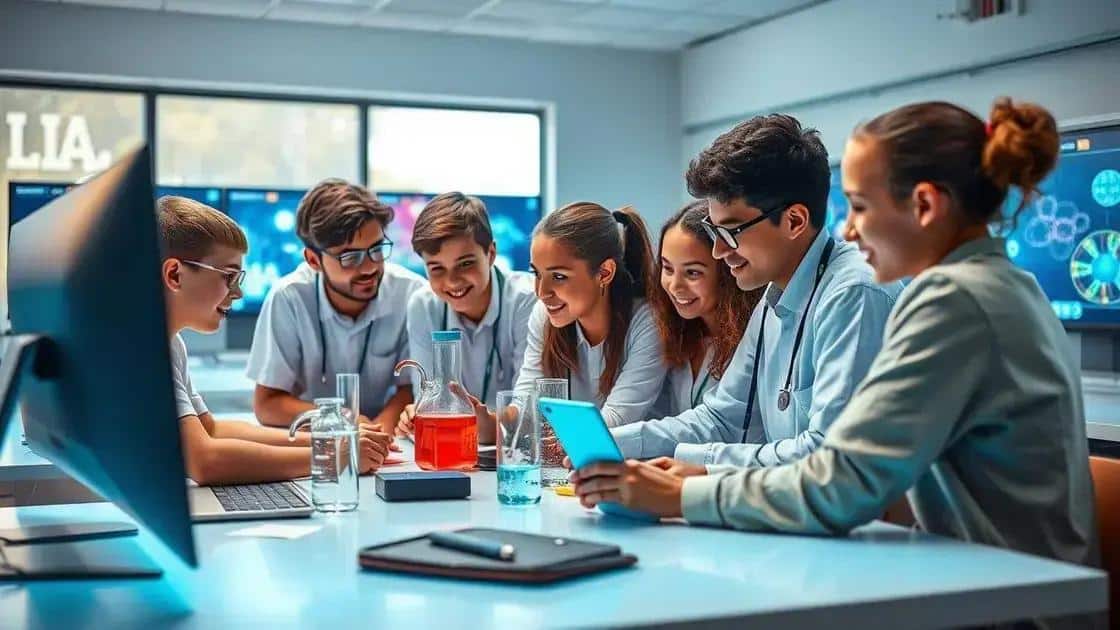
Virtual lab simulations offer numerous benefits that enhance the learning experience for students. These interactive platforms enable learners to engage actively with complex scientific concepts, making education more effective and enjoyable.
One of the primary advantages of virtual labs is the ability to conduct experiments without the limitations of a physical lab. Students can explore various scenarios and outcomes safely, fostering a deeper understanding of the subject matter. This flexibility leads to greater experimentation, which helps solidify knowledge.
Key benefits of virtual lab simulations
- Accessibility: Students from varying backgrounds can access advanced laboratory experiences anytime and anywhere.
- Cost-effectiveness: Virtual labs reduce the need for costly equipment and lab space, making science education more affordable.
- Immediate feedback: Many simulations provide instant results, allowing students to learn from their mistakes quickly.
Furthermore, virtual labs cater to diverse learning styles. Students who thrive in hands-on environments can benefit greatly from these simulations. They can manipulate variables in real-time, observing the effects of their actions without fear of failure or harm.
Another significant aspect of virtual lab simulations is their ability to improve collaboration among peers. Students can work together on projects from different locations, sharing insights and learning from each other. This collaborative approach enhances teamwork skills, which are vital in scientific careers.
As technology continues to evolve, the benefits of virtual lab simulations are likely to expand. Innovations in artificial intelligence and machine learning may offer even more personalized learning experiences, catering to individual students’ needs and pacing. Overall, these tools are bridging the gap between theory and practical application, significantly enhancing the science education landscape.
How virtual labs enhance practical learning experiences
Virtual labs have become an essential tool in education as they significantly enhance practical learning experiences. By using simulations, students gain hands-on experience in a safe environment, allowing them to experiment freely without the fear of accidents.
One of the primary ways that virtual labs improve learning is through interactive experiments that mimic real-life scenarios. Students can manipulate variables and witness the consequences of their actions immediately. This immediate feedback is crucial for understanding complex scientific concepts, as it reinforces learning through practical application.
Engagement through interactivity
Engagement is a key factor in education, and virtual labs offer numerous interactive features that keep students involved. Elements like gamified scenarios and problem-solving challenges make learning fun. By actively participating, students are more likely to retain information and develop a genuine interest in the subject matter.
- Access to diverse experiments: Virtual labs provide a wider range of experiments that may not be feasible in a traditional classroom.
- Safe exploration: Students can explore dangerous chemical reactions or complex biological processes without any risk to their safety.
- Boosted confidence: With repeated practice in a virtual setting, students build confidence in their abilities to perform complex tasks.
Additionally, virtual labs cater to various learning paces and styles. Some students may need more time with particular concepts, while others might quickly grasp them. This flexibility allows for a more personalized education experience. Students can revisit various simulations as needed, enhancing their understanding and comfort with the material.
The collaborative aspect of virtual labs also plays an important role. Students can work together on projects or share findings, enhancing their teamwork skills. This collaboration prepares them for real-world scenarios where teamwork is essential. Furthermore, virtual labs often include features that allow teachers to track student progress and identify areas where they may need additional help.
In essence, by bridging the gap between theory and practice, virtual labs open up a world of possibilities for students. They provide essential skills and knowledge that will benefit students today and in their future careers.
Future trends in virtual lab simulations
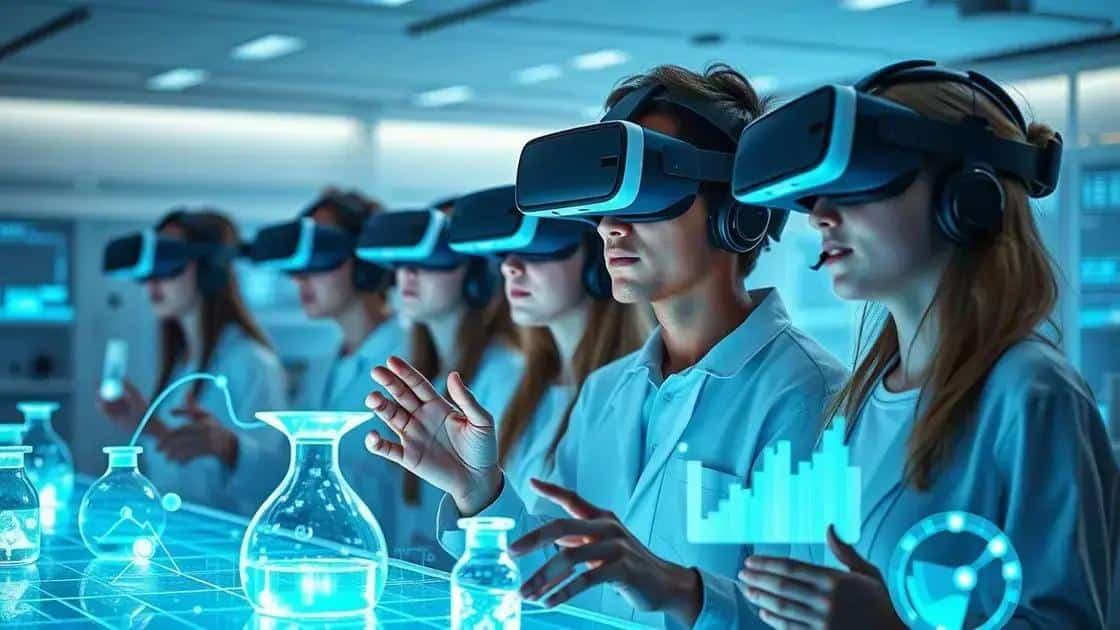
The future of virtual lab simulations looks very promising, with several emerging trends set to reshape how students learn. These technological advancements will enhance the educational experience, making it more interactive and engaging.
One major trend is the integration of artificial intelligence (AI) into virtual labs. AI can tailor simulations to meet individual student needs by adjusting complexity based on their performance. This personalization ensures that each student progresses at their own pace and receives the support they require.
Advancements in technology
Another exciting development is the use of augmented reality (AR) and virtual reality (VR). These technologies allow students to immerse themselves in detailed simulations, experiencing scientific concepts in a highly interactive manner. Imagine conducting a physics experiment in a fully virtual environment where you can manipulate objects and see the effects instantly. This level of integration can foster deeper learning.
- Increased realism: Future simulations will likely incorporate even more realistic graphics and physics, enhancing the learning experience.
- Gamification: Elements of gaming will be more prevalent, turning learning into an adventure that engages students emotionally and intellectually.
- Data analytics: Enhanced data collection will allow teachers to track student progress more effectively, identifying areas for improvement.
Collaboration features are also expected to become more sophisticated. Students may engage in project-based learning with peers around the world, sharing experiments and ideas in real-time. This global interaction enriches their education and helps them develop critical teamwork skills.
Moreover, the rise of cloud-based platforms will likely make virtual labs even more accessible. Students will be able to access their experiments from any device, breaking down traditional barriers associated with lab access. This portability fosters independent learning as students can explore subjects beyond the classroom’s constraints.
As we look to the future, it is clear that virtual lab simulations will play an essential role in shaping the educational landscape. By harnessing these technologies, educators can empower students with the skills and knowledge they need for the challenges ahead.
In conclusion, virtual lab simulations offer amazing opportunities for students to explore scientific concepts in a safe and interactive way. These tools not only enhance practical learning experiences but also build essential skills like collaboration and critical thinking. As technology advances, the future of virtual labs promises to be even more exciting, making education accessible and engaging for all. Virtual labs are indeed paving the way for a brighter learning environment.
FAQ – Frequently Asked Questions about Virtual Lab Simulations
What are virtual lab simulations?
Virtual lab simulations are digital environments where students can conduct experiments and explore scientific concepts interactively and safely.
What benefits do virtual lab simulations offer to students?
They enhance hands-on learning, provide immediate feedback, foster collaboration, and allow for personalized learning experiences.
How do AI and VR improve virtual labs?
AI personalizes learning experiences, while VR creates immersive environments where students can engage with material in a realistic way.
Can students collaborate on virtual lab projects?
Yes, many virtual lab platforms allow students to work together on projects, sharing insights and findings in real-time.


